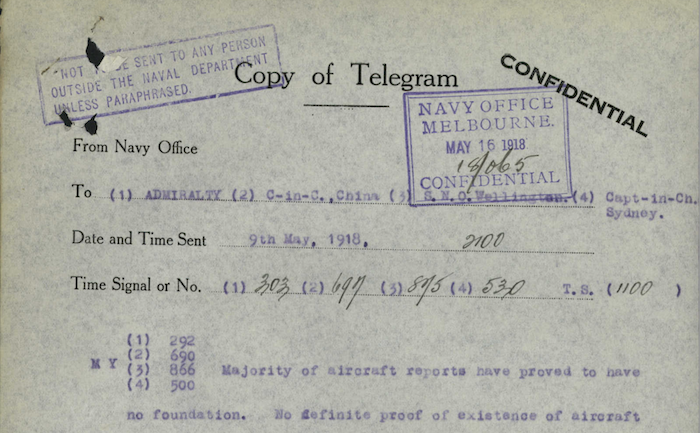
NAA: MP1049/1, 1918/066, page 842 is a copy of a statement by Joseph Jenkin, a farmer from (or near) Woomelang, witnessed by Mounted Constable J. C. Thornton, Victoria Police. It reads:
that at about 8 a.m. on 11th May 1918 I was inside my house gettinh [sic] ready to go to Woomelang when I heard a noise similar to that of a motor car which seemed to be quite close to the house. I went outside to see who it was and what they wanted; but could not see a motor-car in sight, I can see a distance of about 1 mile in any direction from my house and am posively [sic] sure that there was not a motor-car about. I did not think to look into the sky for an aeroplane, but I now feel confident that it was one. At 9.5 a.m. on the same day I again heard the noise which did not last for quite a minute. I looked again to see a motor car approaching but could not see one in sight. I put my horse in the gig & went to Woomelang and there were no fresh motor car tracks on any of the roads. On my way home I took particular notice of the cross roads and could not see any fresh motor car tracks. The first noise I heard lasted a little longer than the second and both sounded alike which sounded like a motor engine being eased off. If there had been a motor car on the road the tracks would have been conspicuous as there had been rain during the night previous.
Thornton also took statements (at NAA: MP1049/1, 1918/066, page 841) from three other Woomelang residents, John Kelly, who had also heard an engine at the same time as Jenkin without being able to see the source, and Alice Ussing and Mary Harper, who at 8.45pm the night before independently saw a bright light to the south, high above the ground. (Achernar was setting then to the south, but maybe Canopus, at about 40 or so degrees above the horizon, fits ‘high’.)
In my article, I use Jenkin’s statement as evidence for the thought process witnesses might have gone through when seeing or, as in this case, hearing something unusual. It’s clear that the sound of a combustion engine was sufficiently unusual in a rural area like this for Jenkin to go outside to look when he heard one; but equally, he was familiar enough with motor cars to know what their tyre tracks looked like. So they were not all that rare, just uncommon. Conversely, aeroplanes were almost literally unimaginable: Jenkin didn’t at first that the engine noise could be coming from the sky, so he didn’t look there. Kelly, his neighbour, said much the same thing. In fact, as Thornton’s own report (at NAA: MP1049/1, 1918/066, pages 843 to 844) reveals, it was only after discussing the mysterious sound with each other that ‘They afterwards came to the conclusion and now believe that the noise was that of an Aeroplane passing’. Similarly, neither Ussing nor Harper seem to have thought that the light they each saw was anything to do with an aeroplane at the time; it seems that it was only ‘after hearing what Mr Jenkins [sic] had said’ that they came forward with their information (though Harper, at least, did think it sufficiently strange at the time to point out to her husband). So ‘hearing/seeing an aeroplane’ in this case was a social construction, a mutual conclusion arrived at after the fact through peer discussion.
![]() This work is licensed under a Creative Commons Attribution-NonCommercial-NoDerivatives 4.0 International License.
Permissions beyond the scope of this license may be available at http://airminded.org/copyright/.
This work is licensed under a Creative Commons Attribution-NonCommercial-NoDerivatives 4.0 International License.
Permissions beyond the scope of this license may be available at http://airminded.org/copyright/.



